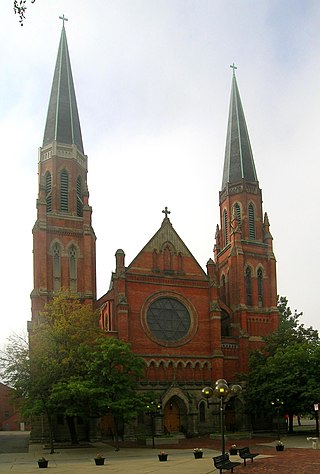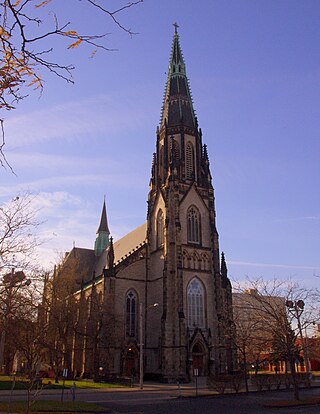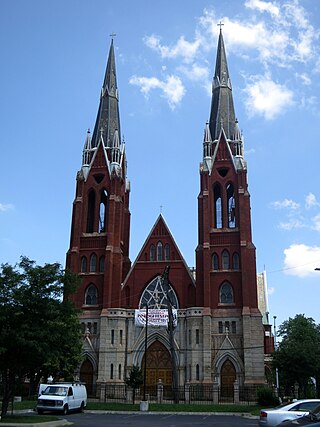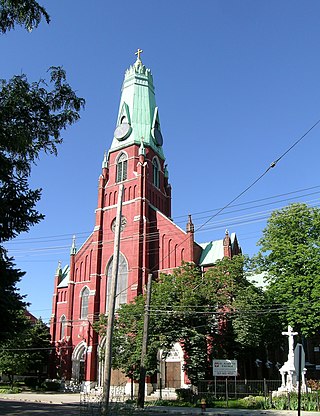
The Archdiocese of Detroit is a Latin Church ecclesiastical territory or archdiocese of the Catholic Church covering the Michigan counties of Lapeer, Macomb, Monroe, Oakland, St. Clair, and Wayne. It is the metropolitan archdiocese of the Ecclesiastical Province of Detroit, which includes all dioceses in the state of Michigan. In addition, in 2000 the archdiocese accepted pastoral responsibility for the Catholic Church in the Cayman Islands, which consists of Saint Ignatius Parish on Grand Cayman.

Josaphat Kuntsevych, OSBM was a Basilian monk and archeparch of the Ruthenian Uniate Church who on 12 November 1623 was killed by an angry mob in Vitebsk, in the eastern peripheries of the Polish–Lithuanian Commonwealth. He remains one of the best-known victims of anti-Catholic violence related to implementing the Union of Brest, and has been declared a martyr and saint of the Catholic Church.

Basilica of Sainte Anne de Détroit (Sainte-Anne-de-Détroit) was founded July 26, 1701 by French colonists in New France, and is the second-oldest continuously operating Roman Catholic parish in the United States. The current Gothic Revival cathedral-styled church, built in 1886, is located at 1000 St. Anne Street in Detroit, Michigan, in the Hubbard-Richard neighborhood, near the Ambassador Bridge, and the Michigan Central Station. At one time it was the seat of a diocese that included French territory in Ontario, Canada south of the Detroit River.

The Basilica of St. Josaphat, located in the Lincoln Village neighborhood of Milwaukee, Wisconsin, United States, in the Archdiocese of Milwaukee, is one of 82 minor basilicas found in the United States. In its grandeur and opulence it is an excellent example of the so-called Polish Cathedral style of church architecture found in the Great Lakes region of North America. Modeled after St. Peter's Basilica in Rome, it features one of the largest copper domes in the world. It is listed on the National Register of Historic Places and is a designated Milwaukee Landmark.

St. Florian Church is a Roman Catholic Church at 2626 Poland Street in Hamtramck, Michigan. The church was designed by Ralph Adams Cram of the firm Cram and Ferguson.

The Cathedral of the Most Blessed Sacrament is a Neo-Gothic style Roman Catholic cathedral church in the United States. It is the seat of the archbishop of the Roman Catholic Archdiocese of Detroit. The metropolitan archdiocese for the Roman Catholic Ecclesiastical Province of Detroit includes all dioceses in the state of Michigan; in addition, in 2000 the archdiocese accepted pastoral responsibility for the Roman Catholic Church in the Cayman Islands, which consists of Saint Ignatius Parish on Grand Cayman. The cathedral is located at 9844 Woodward Avenue in Detroit, Michigan, adjacent to Detroit's Boston-Edison Historic District. The cathedral was listed on the National Register of Historic Places in 1982.

Saint Stanislaus Kostka Catholic Church is a historic Polish church of the Roman Catholic Archdiocese of Chicago that is located at 1351 West Evergreen Avenue in the Pulaski Park neighborhood of Chicago, Illinois, United States. It is designated as the Sanctuary of Divine Mercy of the Archdiocese.

Holy Trinity Church is a historic church of the Roman Catholic Archdiocese of Chicago located at 1118 North Noble Street. It is a prime example of the so-called 'Polish Cathedral style' of churches, in both its opulence and grand scale. Along with such monumental religious edifices as St. Mary of the Angels, St. Hedwig's or St. John Cantius, it is one of the many Polish churches that dominate over the Kennedy Expressway in the Pulaski Park neighborhood of Chicago, Illinois.

St. Mary of Perpetual Help - historic church of the Roman Catholic Archdiocese of Chicago located in the Bridgeport neighborhood of Chicago, Illinois.

St. Joseph Shrine, founded in 1855, is a historic German Catholic church located at 1828 Jay Street in the Eastern Market–Lafayette Park neighborhood area just outside downtown Detroit, Michigan, on the city's central east side. The building was listed on the National Register of Historic Places in 1972, and deemed "of national importance" because of its stained glass. Three subsidiary buildings—the rectory, convent, and the Wermers House—were added to the listing in 1992. It is under the jurisdiction of the Archdiocese of Detroit, and presently a shrine dedicated to the celebration of the pre-Vatican II liturgy under the care of the canons of the Institute of Christ the King Sovereign Priest.

The Sweetest Heart of Mary Roman Catholic Church is located at 4440 Russell Street in Detroit, Michigan, in the Forest Park neighborhood on the city's central East side. The Gothic Revival cathedral styled church is the largest of the Roman Catholic churches in the City of Detroit. It was designated a Michigan State Historic Site in 1974 and listed on the National Register of Historic Places in 1978. It, along with St. Albertus Roman Catholic Church, 0.4 miles east on East Canfield Street, and St. Josaphat Roman Catholic Church, 0.3 miles west at East Canfield Street and Chrysler Drive, served the large Polish community through most of the twentieth century. In a diocesan reorganization instituted by Archbishop Allen Vigneron in 2013, Sweetest Heart of Mary joined with St. Josephat to form Mother of Divine Mercy Parish.

The Sacred Heart Roman Catholic Church, Convent and Rectory is a Roman Catholic church complex located at 1000 Eliot Street in Detroit, Michigan. It was designated a Michigan State Historic Site in 1975 and listed on the National Register of Historic Places in 1980.

The Chapel of St. Theresa–the Little Flower was a church located at 58 Parsons Street in Midtown Detroit, Michigan. It was later known as St. Patrick Church. The building was listed on the National Register of Historic Places in 1997, and demolished in September 2023.

Sts. Peter and Paul Academy is a Catholic school building located at 64 Parsons Street in Midtown Detroit, Michigan. It currently serves as the St. Patrick Senior Center. It was listed on the National Register of Historic Places in 1997.

St. Albertus Roman Catholic Church is in the Forest Park neighborhood of Detroit, Michigan. It was designated a Michigan State Historic Site in 1974 and listed on the National Register of Historic Places in 1978.

Saint Joseph's Roman Catholic Church was a historic Roman Catholic church building in Mobile, Alabama, United States. It served as the parish church for St. Joseph's Parish in the Roman Catholic Archdiocese of Mobile.

The Most Holy Redeemer Church is located at 1721 Junction Street in Southwest Detroit, Michigan, within the West Vernor–Junction Historic District. The church was once estimated as the largest Roman Catholic parish in North America. West Vernor–Junction Historic District is adjacent to Mexicantown and contains a growing Mexican community and resurgent neighborhood.

St. Mary Roman Catholic Church, formally the Church of the Immaculate Conception of the Blessed Virgin Mary, is in the third oldest Roman Catholic parish in Detroit, Michigan. Designed by German-born Peter Dederichs and built for the formerly ethnic German parish of the 19th century, it is located at 646 Monroe Street in what is now considered the heart of the Greektown Historic District in downtown Detroit. It is often called "Old St. Mary's Church" to avoid confusion with other St. Mary's parishes: in the Redford neighborhood of Detroit, or in nearby Royal Oak, Monroe, or Wayne.

Guardian Angels Church is a Roman Catholic church located at 371-375 Fifth Street in Manistee, Michigan. It was listed on the National Register of Historic Places in 2020. Along with St. Joseph Church, Guardian Angels Church is part of Divine Mercy Parish in the Diocese of Gaylord.



























